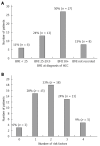Characteristics of hepatocellular carcinoma in cirrhotic and non-cirrhotic non-alcoholic fatty liver disease
- PMID: 25632192
- PMCID: PMC4306163
- DOI: 10.3748/wjg.v21.i4.1189
Characteristics of hepatocellular carcinoma in cirrhotic and non-cirrhotic non-alcoholic fatty liver disease
Abstract
Aim: To determine characteristics and prognostic predictors of patients with hepatocellular carcinoma (HCC) in association with non-alcoholic fatty liver disease (NAFLD).
Methods: We reviewed the records of all patients with NAFLD associated HCC between 2000 and 2012. Data collected included demographics; histology; presence or absence of cirrhosis, size and number of HCC, alpha-fetoprotein, body mass index (BMI), and the presence of diabetes, hypertension, or dyslipidaemia.
Results: Fifty-four patients with NAFLD associated HCC were identified. Mean age was 64 years with 87% male. Fifteen percent (8/54) were not cirrhotic. 11%, 24% and 50% had a BMI of <25 kg/m2, 25-29 kg/m2 and ≥30 kg/m2 respectively. Fifty-nine percent were diabetic, 44% hypertensive and 26% hyperlipidaemic. Thirty-four percent of the patients had ≤1 of these risk factors. Non-cirrhotics had a significantly larger mean tumour diameter at diagnosis than cirrhotics (P=0.041). Multivariate analysis did not identify any other patient characteristics that predicted the size or number of HCC.
Conclusion: HCC can develop in NAFLD without cirrhosis. At diagnosis such tumours are larger than those in cirrhotics, conferring a poorer prognosis.
Keywords: Cryptogenic cirrhosis; Hepatocellular carcinoma; Metabolic syndrome; Non-alcoholic fatty liver disease; Screening.
Figures

References
-
- Vernon G, Baranova A, Younossi ZM. Systematic review: the epidemiology and natural history of non-alcoholic fatty liver disease and non-alcoholic steatohepatitis in adults. Aliment Pharmacol Ther. 2011;34:274–285. - PubMed
-
- Younossi ZM, Stepanova M, Afendy M, Fang Y, Younossi Y, Mir H, Srishord M. Changes in the prevalence of the most common causes of chronic liver diseases in the United States from 1988 to 2008. Clin Gastroenterol Hepatol. 2011;9:524–530.e1; quiz e60. - PubMed
-
- Arase Y, Kobayashi M, Suzuki F, Suzuki Y, Kawamura Y, Akuta N, Imai N, Kobayashi M, Sezaki H, Matsumoto N, et al. Difference in malignancies of chronic liver disease due to non-alcoholic fatty liver disease or hepatitis C in Japanese elderly patients. Hepatol Res. 2012;42:264–272. - PubMed
-
- Söderberg C, Stål P, Askling J, Glaumann H, Lindberg G, Marmur J, Hultcrantz R. Decreased survival of subjects with elevated liver function tests during a 28-year follow-up. Hepatology. 2010;51:595–602. - PubMed
Publication types
MeSH terms
LinkOut - more resources
Full Text Sources
Other Literature Sources
Medical

